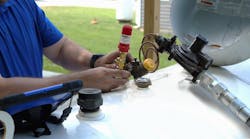In a letter to Transportation Secretary Ray LaHood, American Trucking Associations President and CEO Bill Graves called on the Federal Motor Carrier Safety Administration and Department of Transportation to make real progress toward a national clearinghouse for drug and alcohol test results for commercial drivers.
“I read with great interest last week the results of FMCSA’s recent drug and alcohol strike force sweep. ATA is pleased that both DOT and FMCSA are committed to improving truck and highway safety through stepped up enforcement, and in this case, through focused drug and alcohol inspections,” Graves wrote in a July 2 letter. “However, I continue to be very disappointed with the lack of tangible progress by DOT and FMCSA on a national drug and alcohol test results clearinghouse…”
ATA, in addition to being a strident supporter of drug and alcohol testing, has for the last decade lobbied FMCSA and Congress to establish a clearinghouse for test results in order to close a significant loophole in the rules and prevent “job hopping” by drivers who violate the drug and alcohol rules.
FMCSA has told Congress they intend to create such a clearinghouse, but progress has been imperceptible outside the agency. In fact, progress has been so slow that Congress, as part of the recently passed highway bill, just ordered the agency to create the clearinghouse.
“ATA supports increased enforcement of the drug and alcohol regulations,” Graves says. “We know, however, that two weeks of increased emphasis each year will only have a small, episodic effect on the problem. The long overdue national clearinghouse will be a far more effective way to address the ongoing problem of some commercial drivers evading testing program rules.”








